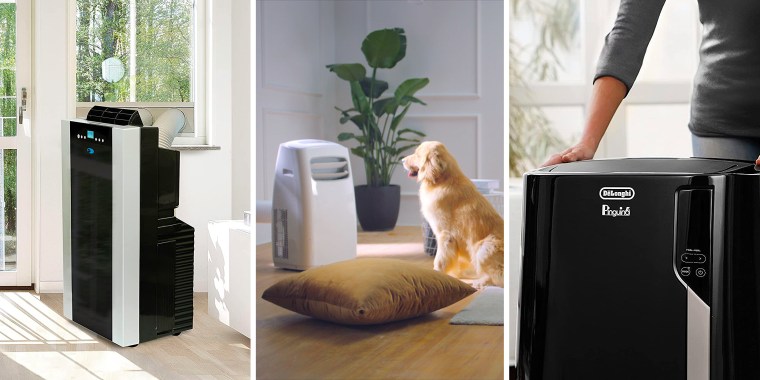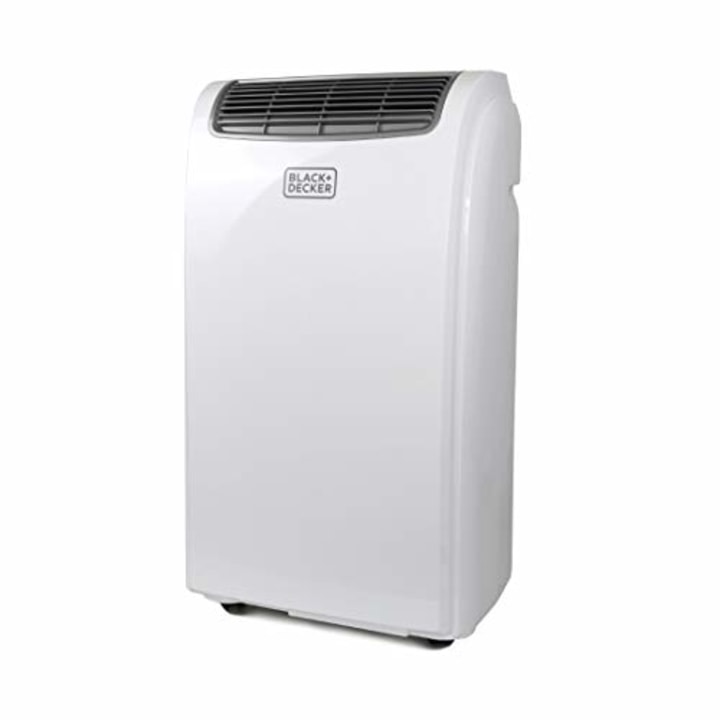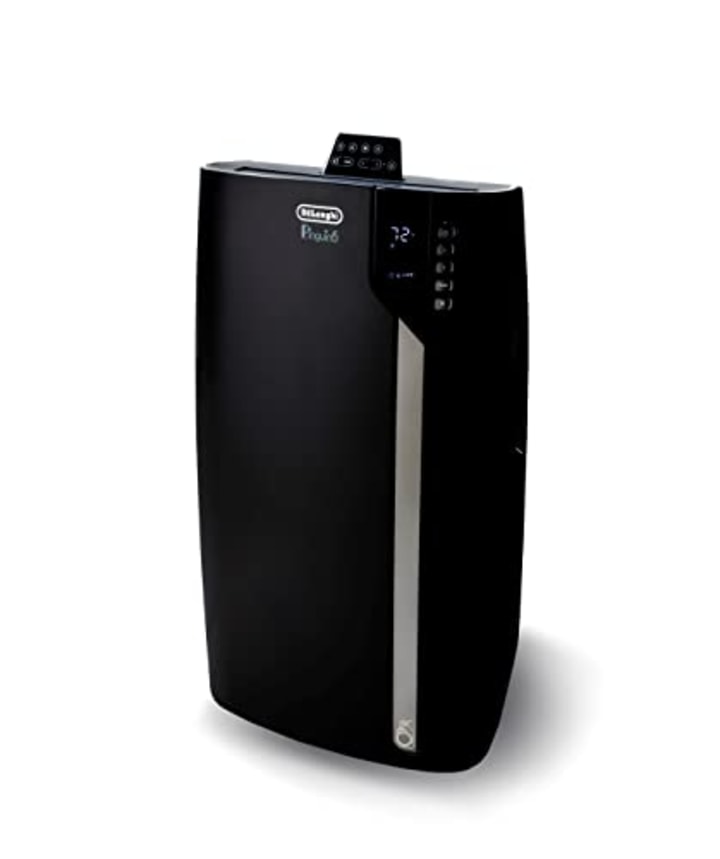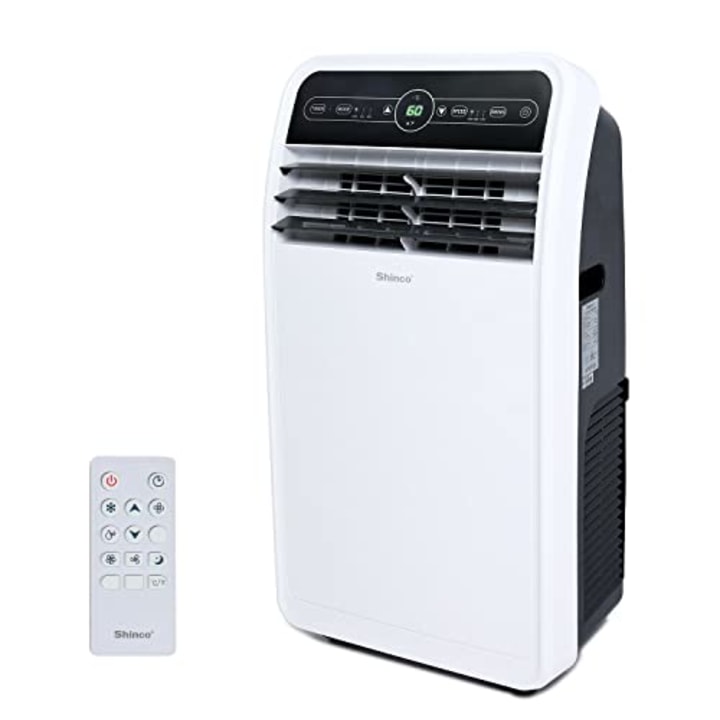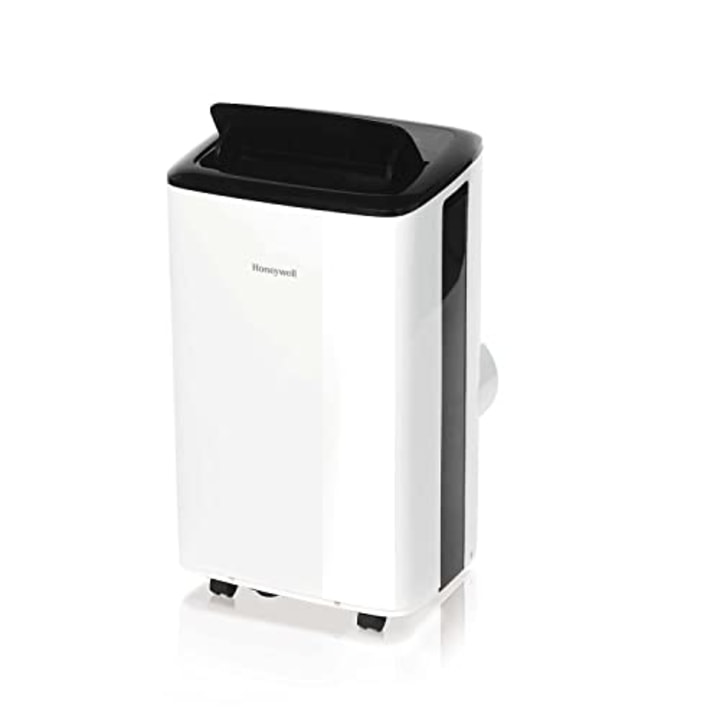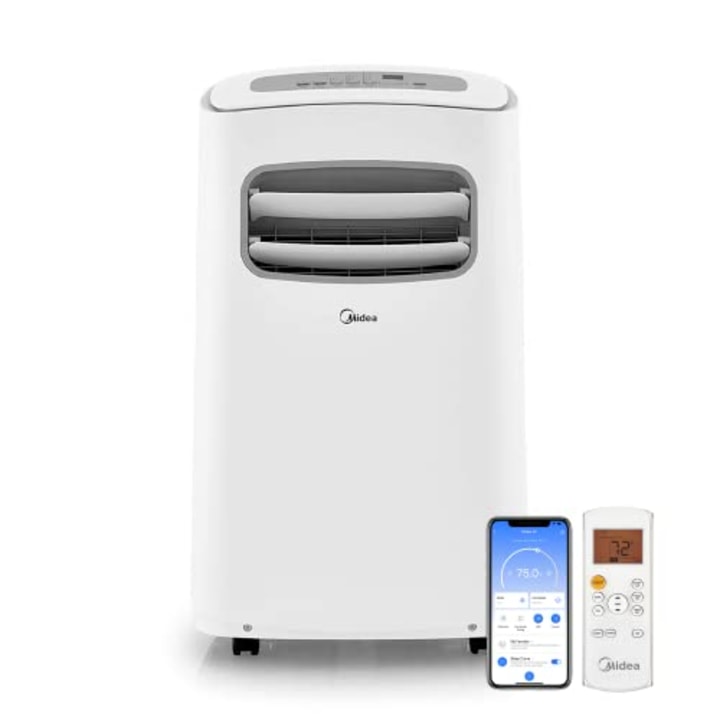When you hear the words “air-conditioning unit,” most people think of a window AC. It’s the heavy, boxy unit that sits awkwardly in your window for a few months every summer. Once the weather turns cool, however, window AC units are either unused, preventing you from using your window, or have to be uninstalled by hand.
If you want that fresh, breezy air without the stress of installing and uninstalling window air conditioners, a portable AC unit can be a great solution. These self-contained systems are ideal for cooling single rooms, don’t block the natural light coming in from a window and can be moved around from room to room year-round. They are also relatively easy to set up.
To help you find the best portable air conditioner, we spoke with cooling and appliance experts. We also rounded up some top-rated models based on their advice, including budget-friendly, smart and high-end options for different-sized rooms.
SKIP AHEAD Top-rated portable air conditioning units for 2023 | How portable air-conditioning units work | The best number of BTUs for your room size | How to shop for a portable air-conditioning unit
Our top picks
- For smaller rooms: Black+Decker 8,000 BTU Portable Air Conditioner
- For larger rooms: DeLonghi Pinguino 14,000 BTU Portable Air Conditioner
- Most affordable: Shinco 10,000 BTU Portable Air Conditioner
How we picked top-rated portable air conditioning units
To pick the best portable air conditioners on the market, we spoke with experts who advised us on the most important features to look for. Following their guidance, we selected top-rated units that met the following criteria:
- Room size: We picked portable air conditioners fit for different room sizes ranging from 200 to 700 square feet.
- Portability: Portable air conditioners often weigh over 50 pounds. To make them easier to move around, we only recommend portable air conditioners with built-in wheels. We also selected a range of small and larger products.
- Top-rated: We only selected portable AC units with at least a four-star average rating from customers on Amazon.
- Functionality: All of our selections have additional fan and dehumidifier functions, as well as washable filters that catch dust.
Top-rated portable air conditioning units for 2023
Below are our top picks for air-conditioning units designed for easy installation and portability. We’ve highlighted their cooling power, the size of room they can best accommodate (according to the brand) and more.
For smaller rooms: Black+Decker
Black+Decker 8,000 BTU Portable Air Conditioner (BPACT08WT)
This unit from Black+Decker is one of the smallest and most lightweight on our list. It’s best suited for smaller rooms like bedrooms and offices up to 350 square feet. While a few size options are available, this 8,000 BTU version is the lowest priced.
Like all of our picks, you can adjust the settings on the unit itself or via the remote. Bonus settings include a timer, sleep and auto mode. It’s also a best seller on Amazon, with a 4.3-star average rating from over 41,000 customer reviews.
Modes: Cool, fan, dehumidify | Cooling power: 8,000 BTUs | Room size: Up to 350 square feet | Hose type: Single hose | Speeds: 3 | Weight: 52.9 lbs. | Dimensions: 15.3 D x 14 W x 24.8 H inches
For large rooms: De'Longhi
DeLonghi 14,000 BTU Portable Air Conditioner (PAC EX390LVYN)
Cooling larger rooms requires a lot more power. With 14,000 BTUs of cooling, this portable AC from DeLonghi is designed to cool spaces up to 700 square feet. This unit monitors temperature and humidity, and will automatically adjust its settings to create a good balance between the two, according to the brand. It also has motorized fan slats that can oscillate to more evenly spread cool air around your space.
This is the largest, heaviest and priciest unit on our list, but that makes sense — it’s rated to cool the largest amount of space.
Modes: Cool, fan, dehumidify | Cooling power: 14,000 BTUs | Room size: Up to 700 square feet | Hose type: Single hose | Speeds: 3 | Weight: 83 lbs. | Dimensions: 18.3 D x 34.3 W x 20.1 inches
Most affordable: Shinco
Shinco 10,000 BTU Portable Air Conditioner (SPF1-10C)
This portable AC unit from Shinco is the cheapest on our list at under $300. Despite its lower cost, it is rated for rooms up to 300 square feet, making it a good option for anyone seeking good value. It has a swing mode that automatically oscillates the fan grille up and down to better distribute cool air. You can switch between modes and set a timer via the on-unit controls or wireless remote control.
You do compromise on a few features, though. There is no smart connectivity and the remote does not have a temperature readout like our recommended Black+Decker and Midea units. While this AC is powerful for the price, light sleepers may want to avoid it — some customers on Amazon say it is loud, even on low settings.
Modes: Cool, fan, dehumidify | Cooling power: 10,000 BTUs | Room size: Up to 300 square feet | Hose type: Single hose | Speeds: 3 | Weight: 61.6 lbs. | Dimensions: 13.39 D x 17.44 W x 32.68 H inches
Small and portable: Honeywell
Honeywell 10,000 BTU Smart Wi-Fi Portable Air Conditioner (HF0CESVWK6)
Select editorial director Lauren Swanson and I have both used Honeywell portable air conditioners in the past, but both of our units have been discontinued. This more up-to-date model is rated for medium-sized rooms up to 450 square feet. It is also slightly more compact than other 10,000 BTU units like the Shinco.
This unit distinguishes itself with its smaller size and smart connectivity. You can connect the unit to your home WiFi and control it through your phone via the Honeywell Air Comfort app and Amazon Alexa.
Modes: Cool, fan, dehumidify | Cooling power: 10,000 BTUs | Room size: Up to 450 square feet | Hose type: Single hose | Speeds: 3 | Weight: 62.8 lbs. | Dimensions: 16.3 D x 13.6 W x 28 H inches
Smart controlled: Midea
Midea 10,000 BTU Portable Air Conditioner
Midea is a Select favorite brand — we’ve written about their excellent Midea U window AC unit before. Similar to that model, this Midea portable AC unit is a good fit for anyone with a smart home. When connected to Wi-Fi and synced with the MideaAir app, you can control it through voice controls with Amazon Alexa or Google Assistant. Smart connected and a smaller 200 square foot room rating make this unit a good fit for a high-tech office or media room.
Do note that smart connectivity drives up the price of this unit — it is more expensive than similarly-powerful units from brands like Black+Decker and Shinco.
Modes: Cool, fan, dehumidify | Cooling power: 10,000 BTUs | Room size: Up to 200 square feet | Hose type: Single hose | Speeds: 3 | Weight: 67.9 lbs | Dimensions: 13 D x 17.1 W x 28.3 H inches
Dual-hose: Whynter
Whynter ARC-14S 14,000 BTU Dual-Hose Portable Air Conditioner
This Whynter ARC-14S portable AC is the only dual-hose model on our list. Unlike single-hose units, which recirculate air from within your space, dual-hose ACs pull fresh air from outside of your home with one hose and expel hot air with the other. Having two hoses does make installation a little more complicated, however.
Another standout is the addition of a carbon filter. Most AC units have a dust filter that helps to filter larger pieces of dust. This unit’s dust and carbon filter work together to filter dust, clear gas and eliminate odors, according to the brand.
Otherwise, it is similar (albeit heavier) to most of our other picks, with three operating modes, three operating speeds, wheels and a wireless remote control.
Modes: Cool, fan, dehumidify | Cooling power: 14,000 BTUs | Room size: Up to 500 square feet | Hose type: Dual hose | Speeds: 3 | Weight: 73 lbs. | Dimensions: 16 D x 19 W x 35.5 H inches
How portable air-conditioning units work
A portable air-conditioning unit sits on the floor with a vent that you can snake through a window or the wall. “Portable air conditioners draw in ambient air from either the room in which they’re located (single hose) or from outside (dual hose),” says Carl Prouty, a tech expert at electronics and appliance retailer Abt. “They cool that air down, then send the cooled air back into the room, while the hot air produced is vented outside through an exhaust hose.”
Free-standing air conditioners are a pricier alternative to window units. However, they’re much easier to install and are typically more compact, so you can move the unit from room to room without much effort, says Dr. John McKeon, CEO of Allergy Standards — an organization that, among other things, certifies products as “asthma & allergy-friendly.”
The best number of BTUs for your room size
An air conditioner’s cooling ability is typically measured in British thermal units or BTUs. The higher the number of BTUs, the more powerful the air conditioner. On average, an air-conditioning unit needs about 20 BTUs per square foot of space to keep things cool, says McKeon. To figure out how many BTUs you need for your room size, multiply the square footage of your room by 20.
Below is a breakdown of the number of BTUs needed to cool different-sized spaces. These calculations are averages — it’s still important to refer to the square footage rating referenced on an AC unit.
- Up to 250 square feet: 5,000 to 6,000 BTUs
- From 250 up to 350 square feet: 7,000 to 8,000 BTUs
- From 350 up to 450 square feet: 9,000 to 10,000 BTUs
- From 450 up to 550 square feet: 12,000 BTUs
- From 550 up to 700 square feet: 14,000 BTUs
“Using an AC with the right amount of power is extremely important,” Prouty says. “A unit that is too powerful will cool the room too quickly. This is bad for two reasons: it won’t do an efficient job of dehumidifying the room and it will cycle on and off too frequently, causing undue stress on the AC, which will cause it to break down prematurely.” On the other hand, says Prouty, a unit that’s not powerful enough won’t cool the room down — it’ll just run continuously, meaning your energy bill will be much higher than it would have been had you bought a portable AC that was the appropriate size, and it’ll break down early, too.
According to Prouty, if you plan on putting your portable AC unit in a sunny space, you should add about 10% to the ideal number of BTUs based on the room’s size. If the room gets little to no sun, you’ll need about 10% less, he says. If there are more than two people typically occupying the room, you’ll need to add 600 BTUs for each additional person, and if it’s going in a kitchen, you’ll need to add 4,000 BTUs to “counteract the additional heat [that] kitchen appliances produce,” says Prouty.
As BTU capacity increases, the weight and size of the model typically will, too.
How to shop for a portable air-conditioning unit
Once you’ve figured out how many BTUs a room will need, our experts say to consider the following:
Hose type
Portable air conditioners either come with a single hose or double hose. Single hose models, which are more common, pull stagnant air from inside your room, cooling and recirculating it throughout. Dual-hose units, on the other hand, have one air exhaust hose and another that pulls fresh air from outside.
According to Prouty, dual-hose units are louder and more expensive. They also require more work: Prouty told us that pulling air from the outside produces condensation, which is stored in a bucket within the unit that you’ll have to empty. (In some cases, he said, you can have a hose run to a floor drain so you don’t need to empty the built-in tank as regularly.)
Smart technology
Some portable air conditioners equip smart technology and can be controlled via smartphone, though these models will typically cost more, says McKeon. Certain models come with added built-in features, like a dehumidifier, heater or air purifier. You may also be able to set a timer to turn the unit on or off at specific times to reduce energy consumption.
Placement and maintenance
Keep in mind your portable air conditioner will need proximity to a window and electrical outlet. Portable ACs require some simple maintenance, including draining the water from the unit as needed and replacing the air filters every couple of weeks. This will help avoid mold growth in your unit, which can decrease your room’s air quality, said McKeon.
Meet our experts
At Select, we work with experts who have specialized knowledge and authority based on relevant training and/or experience. We also take steps to ensure all expert advice and recommendations are made independently and without undisclosed financial conflicts of interest.
- Dr. John McKeon, CEO of Allergy Standards — an organization that, among other things, certifies products as “asthma & allergy-friendly.”
- Carl Prouty is a tech expert at electronics and appliance retailer Abt.
Why trust Select?
Justin Krajeski is a former associate editor at Select on NBC News. For this piece, he spoke with experts like John McKeon and Carl Prouty to better understand portable air conditioners and their complexities.
Hanna Horvath is a personal finance reporter based in New York City and a former contributor to NBC Select.
Harry Rabinowitz is a reporter at Select who has covered consumer tech for years. For this piece, he leveraged his personal experience using portable air conditioners in combination with thorough research of customer reviews to select products to recommend.
Catch up on Select's in-depth coverage of personal finance, tech and tools, wellness and more, and follow us on Facebook, Instagram and Twitter to stay up to date.
